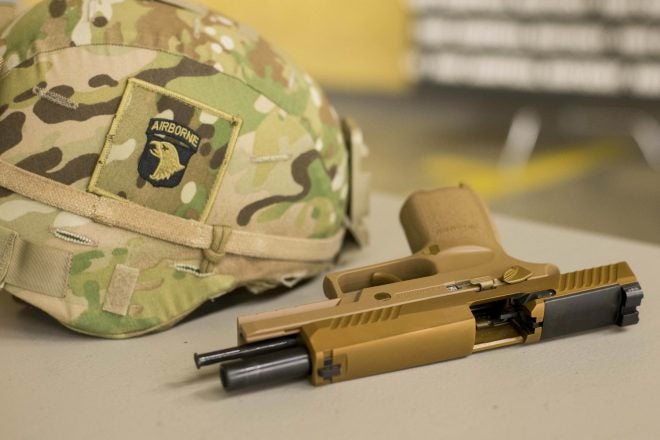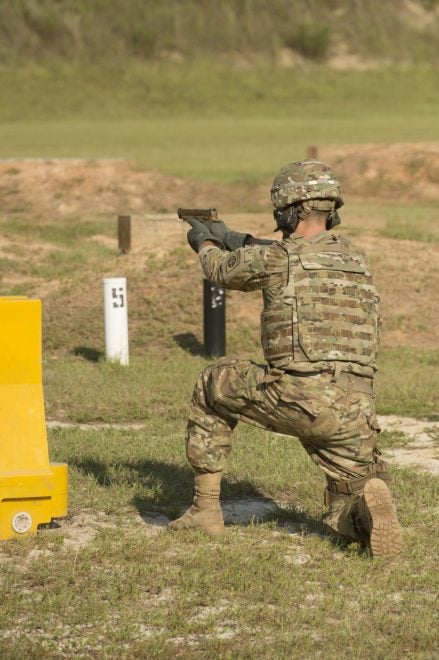A new report from the Director of Operational Test and Evaluation (DOT&E) has revealed that the US Army’s new pistol, the XM17/XM18 Modular Handgun System has suffered from a number of failures during testing.
MHS Suffering Teething Troubles
The 2017 Annual Report, published last month, includes general reports on the progress of testing and development of programs from all service branches and the Department of Defence. The last program report in the section covering the Army’s projects is on the Modular Handgun System.
Testing has taken place before and since the adoption of the XM17, and the report details a number of failings found with the SIG Sauer pistol adopted by the Army in January 2017. These included issued with the pistol’s trigger, feeding issues and a failure of the Mean Rounds Between Stoppage (MRBS) reliability requirement.

The XM17 MHS as first issued with the 101st Airborne. (US Army/Sgt. Samantha Stoffregen)
The much publicised issue with pistols discharging when dropped saw SIG Sauer work with the Army to introduce “lightweight components in the trigger group mechanism.” However, the report suggests that this fix may have led to another issue. Testing found that triggers in two of the pistols tested suffered from ‘splintering’. PEO Soldier has since told Soldier Systems Daily that this was an isolated problem and that the pistols continued to work but that the trigger pull was adversely impacted.
Another issue identified was what the DOT&E referred to as ‘double ejections’. The report states:
Both the XM17 and XM18 pistols experienced double-ejections where an unspent ball round was ejected along with a spent round. Due to the increased frequency of occurrence during Product Verification Test (PVT), the Army stood up a root cause analysis team to identify the cause of the double ejections in parallel with continued PVT. As of this report, this analysis is still ongoing
While this description doesn’t tell us exactly what is going on, it suggests that a live round has been stripped from the magazine and ejected following a spent case. This seems highly unlikely as the slide would have to cycle fully to eject the next case. The malfunction may describe stove-piping or perhaps a round is entering the action at the wrong point in the slide’s travel. Regardless of what the issue is it is now the focus of a root cause analysis team.
The report also notes that the XM17 and XM18 demonstrated “significantly more stoppages” with XM1152 ball ammunition than the new XM1153 Jacketed Hollow Point special purpose ammunition. So much so that the Army continued its PVT testing with just XM1153 JHP, while a root cause analysis team is examining the reason for issues with the XM1152 ball round.

The MHS in its right-side, low slung holster system (U.S. Army/Lewis Perkins)
The new pistol has, however, met accuracy requirements where “10 shots at 35 meters can be covered by a 4-inch disk, with the center of the grouping being no more than 4 inches from the point of aim, 90 percent of the time.” Despite this the report identified a final issue, which appears to have been due to user error. The pistol failed to meet the Mean Rounds Between Stoppage (MRBS) reliability requirement with “slide stoppages accounted for 50 percent of XM17 stoppages, and 75 percent of the XM18 stoppages observed during IOT&E [Initial Operational Test & Evaluation].” These issues can be alleviated with improved pistol training and improving soldiers’ grip to prevent riding of the slide stop.
The report concludes with three recommendations for the Army to action:
The Army should:
1. Upon identification of the root cause of the double ejections and ball ammunition reliability problems, confirm fixes to both the XM17 and XM18 in future testing.
2. Work with the vendor to identify and eliminate cause of variability in the manufacture of the trigger group mechanism.
3. Consider redesign of the slide catch lever or operator training changes to prevent engagement by operators while shooting the pistol.
The DOT&E’s analysis of the Army’s testing is still ongoing with a review of findings for operational effectiveness, operational suitability, and lethality due to be delivered to Congress in the second quarter of 2018.

The new XM17 (MHS) in action at Range 29 Ft. Bragg (U.S. Army/Lewis Perkins)
While many will no doubt cry ‘should have gone with Glock’ it’s important to remember that the US Military’s previous pistol, the Beretta M9, also suffered serious teething troubles when it was first adopted. Early M9’s suffered from a number of catastrophic slide failures, caused by metal fatigue, which led to injured personnel. The issues with the Modular Handgun System will no doubt be addressed in time and it is unlikely that the issues identified in the DOT&E report will slow the pistol’s roll out as it has already been issued to a number of active units.
Source:
‘Director of Operational Test and Evaluation 2017 Annual Report’, DOT&E, retrieved 01/29/18, from source
‘Quality and Safety Problems With the Beretta M9 Handgun, 1988’, GAO, retrieved 02/01/18, from source
 Your Privacy Choices
Your Privacy Choices
